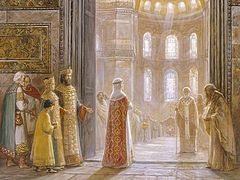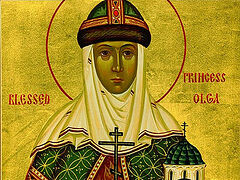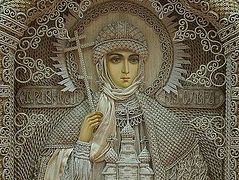Here, on the left bank of the Velikaya River, there once was a village named Vibuty. The river makes a sharp bend here, forming a short and very shallow section called the Vibuty Rapids. From here, it’s a short way down the river to Pskov—just seven-and-a-half miles.
The village is long gone. All that’s left is the cemetery and the adjacent Prophet Elijah Church.
This place wondrously combines a wealth of historic and modern factors. Tradition holds that the future Princess Olga, wife of Igor from the Rurik Dynasty, was born in this area. Moreover, they even met for the first time here—at the Vibutsky Rapids crossing. It’s believed that it was Princess Olga, the first among the rulers of Rus’ to become Orthodox, who ordered to erect a wooden church at the local cemetery. The current Prophet Elijah Church dates back to the fifteenth century. There was definitely another church here earlier, as evidenced by the fact that the Tretyakov Gallery in Moscow has an icon of the holy Prophet Elijah from the church in Vibuty dating back to the thirteenth century.
The church in Vibuty was badly damaged during the Great Patriotic War and restored in the 1950s.
And the Vibuts are closely associated with the 76th Guards Airborne Division stationed thereby. There’s a monument nearby called the Dome, dedicated to the 6th Company that entered eternity during the Second Chechen War. The paratroopers provided invaluable assistance in restoring the church and cleaning up the surrounding area. After all, the Prophet of God Elijah is their patron.
 The Prophet Elijah Church in Vibuty
The Prophet Elijah Church in Vibuty
—Fr. Mikhail, tell us about the church in Vibuty, please.
—It’s a wonderful church. We talk about how it’s from the fifteenth century, but as a matter of fact, there was an older church here before. It was probably wooden. This is the birthplace of Princess Olga, and she surely couldn’t let her homeland go without a church. We have a copy of a thirteenth-century icon. The original is currently in the Tretyakov Gallery, but we have a copy of this icon, and it’s kept in this holy church. Therefore, it can be argued that Princess Olga probably built a wooden church here. Now there’s a church of the fifteenth century that we—myself as rector, and other interested people before me—have restored. Everyone contributed. There were no rich donors or huge funds or anything else. Everyone pitched in, because they understood that the homeland of Princess Olga should have a church worthy of her name—because without her, we simply wouldn’t exist.
—That is, you maintain then that she hails from this area? There are other theories, as far as we know.
—It’s completely unimportant to the people who come here. They come here because this is where she was from. They get help from her because she was a wise woman and a wise ruler. She ruled so wisely that any ruler we have now hopes, I think, to be equal to her.
—And who are your parishioners?
—Well, they should rather be called the “out-of-towners.” As for the parishioners, they’re all here, lying side-by-side. There’s a cemetery here. Ever since the time of Princess Olga, the land has been divided according to churchyards, similar to districts today. But nowadays, these churchyards are simply cemeteries. All of our parishioners are the people buried here. Their relatives visit their graves. There are, of course, the out-of-towners who understand what a special kind of place this is. There’s a lot of them. We hold services regularly, every week, and sometimes more often. We serve Liturgy here. We prayed here all week in the first week of Great Lent. I emphasize that we were here, because I’m also assigned to another parish church. People have difficulty getting to that other church on workdays. But we prayed here in the first week in complete silence, with only the sound of the flowing river. It was very special. We took some photos that we’ve shared on our VKontakte page. We began the services at 6 AM. It’s a special feeling when you see the sun rising and nature awakening before your very eyes. It’s simply amazing! That’s why our parishioners are actually out-of-towners. They come to experience the special atmosphere pervading this place thanks to the figure of Princess Olga. They don’t come to see me as rector, or any former rector. No—they come to Princess Olga.
—There’s an idea that the Pskov land is worlds apart from central Russia, and that its people are different, too. What do you think? Is it true?
—We mustn’t say we’re different. It’d be wrong if we started talking about ourselves like that. May God grant that people see this in us. I always say that a Christian should, in principle, stand apart. We should have such a special way of living that people would see our faith and want to become believers. Here’s something that happened in the Pskov Caves Monastery once. A certain woman from Moscow came running up to Archimandrite John (Krestiankin). She was screaming in terror: “Batiuhska! What’s the deal with Moscow?! It’s impossible to live there!” and so on. Batiushka rebuffed her, saying: “Ah, but you don’t know. There’s a baba on the fifteenth floor there. She prays so hard, so hard!”
—Speaking of missionary activity: Do you do anything to attract people to the church in some way?
The feast of Princess Olga is a great day for the city of Pskov. It’s their city holiday
—Absolutely, except there’s no one to attract here. The locals come by themselves. We try to position our community online to remain visible. The feast of Princess Olga is a great day for the city of Pskov. It’s their city holiday. But we celebrate it the day before, in her native land. Thousands come here on that day. Of course, we try to end it with a church service. There’s a really nice tradition of baptizing people in the river. And, you know, this tradition resonates with people more and more with every passing year. First people come alone, then in pairs, and then by the dozens. People prepare themselves ahead of time for this Sacrament. It’s not out of the blue, of course. They prepare themselves for the Sacrament ahead of time; they come here especially for it, and we make special bridges into the river, and that’s how we baptize them.
—What does it mean for you to serve the people?
—It means love—showing, as I already said, that the life of a Christian is above all a manifestation of love; so those who come to the church would feel this love and want to come back again.
—You’re speaking about love. Will love conquer all?
—Of course! It’s the pledge of what God has left for us. The Apostle and Evangelist St. John the Theologian, who, as you know, died at a venerable old age, repeated just one thing until his last days: “Brethren, love one another.” Just one thing, nothing else—no other instructions. And Archimandrite John (Krestiankin) used to say, standing at the analogion at the Pskov Caves Monastery, that people may not love us, or they may even hate us, but we must necessarily love everyone.
—There’s another church on the territory here. Could you tell us about it as well?
—We’re sitting next to the Prophet Elijah Church right now. There was once a side chapel to St. Nicholas. It hasn’t survived to our day, but there are photos, probably from the 1950s or 1960s, where the walls still remained. In 1993, the church was transferred to the hands of Archpriest Oleg Teor, our famous batiushka. He put things in order here, with the help of the Division. Following the first campaign, when many men didn’t return from Chechnya, the Division Commander S. Y. Semenyuta decided to erect a church to St. Nicholas here, in this holy place. All the guys who helped to build it, who took part in the construction of the church, and who later went on to fight in the Second Chechen campaign returned safely. It’s a miracle. It’s truly a miracle, so anytime the military comes here, we always tell them about it. They keep coming here. You know, the Division is still based in the area. So they come here because the Prophet Elijah is their patron saint. The city holds a festival on the feast of the Prophet Elijah. Of course, they don’t meet at the church, but after the festival, they all come here to venerate the saint, their Heavenly benefactor.
It’s truly a miracle, so anytime the military comes here, we always tell them about it
—Do you have any favorite sayings from the Holy Fathers?
—I’ve already spoken about love. There’s a lot you can say about love. I think love is at the epicenter of everything. God is love, and it fulfills us. So, these sayings are my favorites. But the most important thing is to know how to use them in your life. It’s so hard at times. One time I was reading St. John Chrysostom about who a priest is. A priest doesn’t always live according to his teachings. He has to teach, though. It’s his calling, to teach people. But, when you teach without internalizing it yourself, it’s like when Christ said: Woe unto you also, ye lawyers! for ye lade men with burdens grievous to be borne, and ye yourselves touch not the burdens with one of your fingers (Lk. 11:46). That is, you have to try a shirt on yourself first before trying to give it to someone else.
I like that Great-Schema monks have a tiny casket depicted on the back of their schema, and it says: “Flee vanity O man, for this awaits you.” The remembrance of death is the most important thing in our life. If we live through the prism that today is our last, we would live a completely different life. But, not to sound too plaintive, I’ll say one thing: Each of us must learn to love our neighbor, and then you’ll understand how to love God.








